Replacing an old shower head with a low flow shower head saves water:
- older shower head: 6 gallons (22 litres) of water per minute
- low flow shower head: 2 gallons (7.6 litres) of water per minute
For a 5 minute shower, that's a savings of 20 gallons (72 litres)!
And in fact, 2 gallon per minute shower heads have become so widespread over the past few years that they're now considered old and there are even newer ones that are as low as 1.5 to 0.5 gallons per minute!
And it also saves energy. Since you're using less water, there's less water to be heated.
Meanwhile, you don't notice a difference when showering.
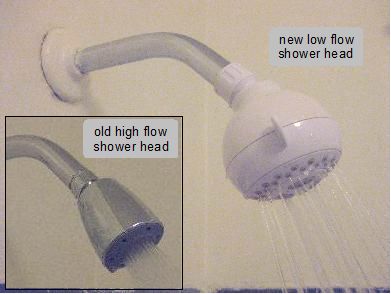
|
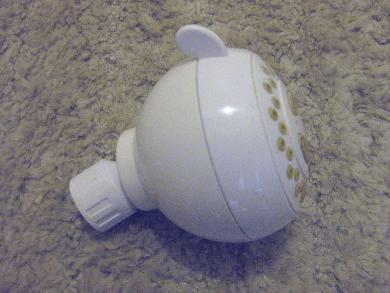
|
Different types of flow shower heads
The three different types are:
- Pulsed - Water is ejected in pulses, on and off, but so quickly that you don't notice it. The times in between bursts when no water is flowing are the times you're saving on water.
- Aerated - Air is injected into the
water so you're actually getting a mix of the two. The savings
is in all the air that you're getting in place of water.
Warning - if you have problems getting enough hot water, such as in an old appartment building with a poorly designed plumbing system, then you may not want an aerator type shower head. This is because the injected air will cool the water a little. - Vacuum - The shower head is designed to create a vacuum used to compress aerated water so that it comes out under pressure.
Adding the ability to turn off the water in mid-shower
Some shower heads allow you to turn off or turn down water flow. This is useful if you are soaping down or shampooing and don't need any water until it's time to rinse. This is often done by pulling a chain or turning something.
My shower head didn't come with that feature so I purchased a separate valve that allows me to do this. The valve goes between the pipe and the shower head as the following photo shows.
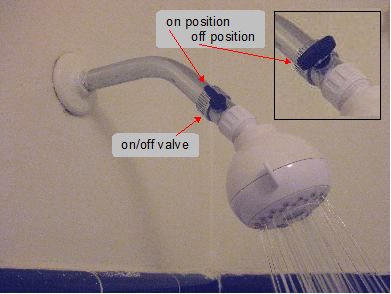
|
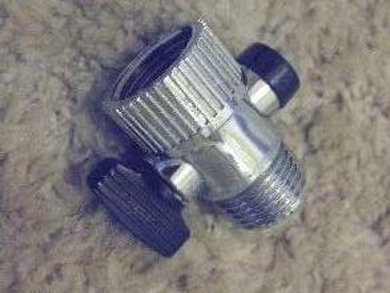
|
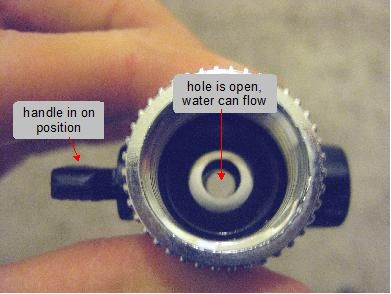
|

|
Measuring water use with and without using the valve
I timed each part of a shower and got the following numbers. I have medium length hair (male). Results are shown where I leave the water running the entire time and where I use the valve to turn off the flow of water during times when I'm just soaping, scrubbing, and/or shampooing and don't need the water running. Two different shower sequences were tried, a 5 step one and a 3 step one, to see if combining things would speed up the process and decrease water use.
5 step shower
| ||||||||||||||||||||||||||||||||||||||||||||||||||||||||||||||||||
So using the valve to turn off the water when not needed and using a 0.5 gallon per minute shower head, a single shower needs only 2 gallons (1.98 rounded up)! Similarly for a 1.9 litre per minute shower head, only 7.5 litres (7.54) is needed!
3 step shower
| ||||||||||||||||||||||||||||||||||||||||||||||||
So combining steps didn't make a significant difference in water use, at least not for my hairy body (:)). It does make a difference for some. Note that the flow from a 0.5 gallon/1.9 litre per minute shower head may be so low as to require longer rinse times, especially if you have long hair, than with a higher flow shower head. Multiplying by one quarter as I've done above may be too simplistic for some.
 |
Drip when the valve is in off position
When the valve is in the off position (no water flowing) then the valve still lets a little water flow out. This is to allow the hot water flowing in the hot water pipe to continue to keep the pipe heated. For example, my hot water pipe runs through the concrete foundation of my building (very poor design!) and in winter, any hot water sitting in the pipe waiting to come out would quickly cool.
I measured the amount of this small drip from my valve and it was 0.15 gallons per minute (0.55 litres per minute). From the last table above, the water flow is off for 2 minutes, 25 seconds, which amounts to a total drip of 0.36 gallons or 1.3 litres.
Foot pedal activated on/off valve
With water in your eyes, you may find it difficult to find the valve. A foot pedal can be devised which is easy to feel for and step on to turn on/off the flow of water. If the valve uses a pull chain instead of the turning knob shown above, then the chain need only be lengthened to reach the foot pedal. Stepping on the foot pedal pulls on the chain enough to toggle the setting, on or off. A spring pushes the pedal back up for the next time you step on it.
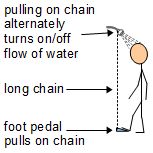 |
How to install a low flow shower head and an on/off valve
The following video goes through the steps to removing your old shower head and installing a low flow shower head as well as an on/off valve.

